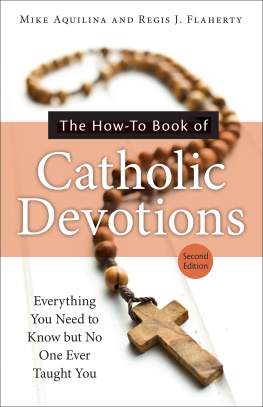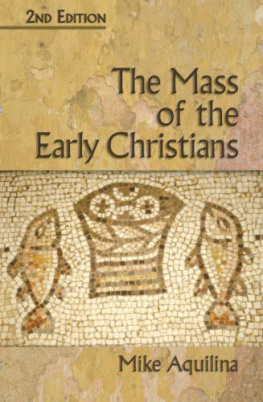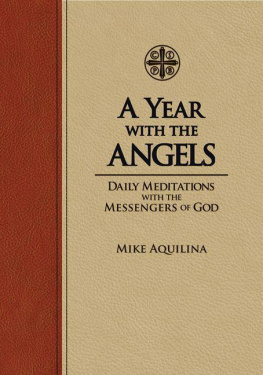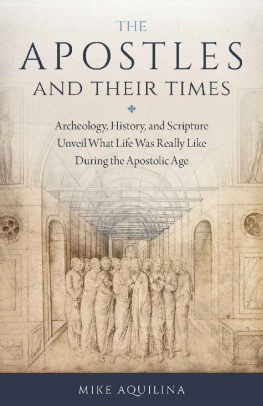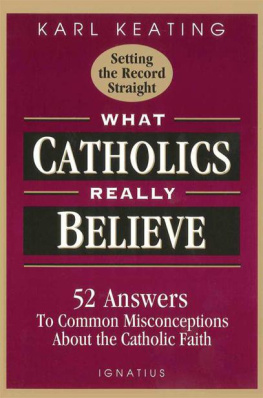Mike Aquilina - The How-To Book of Catholic Devotions
Here you can read online Mike Aquilina - The How-To Book of Catholic Devotions full text of the book (entire story) in english for free. Download pdf and epub, get meaning, cover and reviews about this ebook. year: 2016, publisher: Our Sunday Visitor, genre: Religion. Description of the work, (preface) as well as reviews are available. Best literature library LitArk.com created for fans of good reading and offers a wide selection of genres:
Romance novel
Science fiction
Adventure
Detective
Science
History
Home and family
Prose
Art
Politics
Computer
Non-fiction
Religion
Business
Children
Humor
Choose a favorite category and find really read worthwhile books. Enjoy immersion in the world of imagination, feel the emotions of the characters or learn something new for yourself, make an fascinating discovery.
- Book:The How-To Book of Catholic Devotions
- Author:
- Publisher:Our Sunday Visitor
- Genre:
- Year:2016
- Rating:3 / 5
- Favourites:Add to favourites
- Your mark:
- 60
- 1
- 2
- 3
- 4
- 5
The How-To Book of Catholic Devotions: summary, description and annotation
We offer to read an annotation, description, summary or preface (depends on what the author of the book "The How-To Book of Catholic Devotions" wrote himself). If you haven't found the necessary information about the book — write in the comments, we will try to find it.
The How-To Book of Catholic Devotions — read online for free the complete book (whole text) full work
Below is the text of the book, divided by pages. System saving the place of the last page read, allows you to conveniently read the book "The How-To Book of Catholic Devotions" online for free, without having to search again every time where you left off. Put a bookmark, and you can go to the page where you finished reading at any time.
Font size:
Interval:
Bookmark:

Everything You Need to Know but No One Ever Taught You
Second Edition
Mike Aquilina and Regis J. Flaherty
Our Sunday Visitor Publishing Division
Our Sunday Visitor, Inc.
Huntington, Indiana 46750
Every reasonable effort has been made to determine copyright holders of excerpted materials and to secure permissions as needed. If any copyrighted materials have been inadvertently used in this work without proper credit being given in one form or another, please notify Our Sunday Visitor in writing so that future printings of this work may be corrected accordingly.
Copyright 2016 by Mike Aquilina and Regis J. Flaherty. Published 2016.
23 22 21 20 194 5 6 7 8 9
All rights reserved. With the exception of short excerpts for critical reviews, no part of this work may be reproduced or transmitted in any form or by any means whatsoever without permission from the publisher. For more information, visit: www.osv.com/permissions.
Our Sunday Visitor Publishing Division, Our Sunday Visitor, Inc., 200
Noll Plaza, Huntington, IN 46750; 1-800-348-2440.
ISBN: 978-1-61278-965-1 (Inventory No. T1729)
eISBN: 978-1-61278-971-2
LCCN: 2015953312
Cover design: Lindsey Riesen
Cover art: Shutterstock
Interior design: Dianne Nelson
Printed in the United States of America
Unless otherwise noted, Scripture citations used in this work are from the Revised Standard Version of the Bible Second Catholic Edition (Ignatius Edition), copyright 2006 National Council of the Churches of Christ in the United States of America. Used by permission. All rights reserved.
Some Scripture texts in this work are from the New American Bible, revised edition (NABRE), copyright 2010, 1991, 1986, 1970 Confraternity of Christian Doctrine, Washington, D.C., and are used by permission of the copyright owner. All rights reserved. No part of the New American Bible may be reproduced in any form without permission in writing from the copyright owner.
Quotations from papal and other Vatican-generated documents available on vatican.va are copyright Libreria Editrice Vaticana.
English translation of the Catechism of the Catholic Church (CCC) for use in the United States of America copyright 1994, United States Catholic Conference, Inc. Libreria Editrice Vaticana. English translation of the Catechism of the Catholic Church: Modifications from the Editio Typica copyright 1997, United States Catholic Conference, Inc. Libreria Editrice Vaticana.
Excerpts from the English translation of the Rite of Penance (copyright 1974), the Rite of Baptism for Children (copyright 1969), the Book of Blessings (copyright 1987), and The Roman Missal (copyright 2010), International Commission on English in the Liturgy Corporation (ICEL). All rights reserved.
Did you ever attend a Catholic devotion the Stations of the Cross, for example, or the Angelus and find you were the only person who had no idea what to do next?
Do you ever meet people who seem to pray as if its second nature, and wish you could have what they have?
Do you often wish you had words or gestures to tell God what you really think and feel?
Do you feel something is missing in your life and suspect it might be prayer?
If you answered yes to one or more of these questions, congratulations! Youre normal.
You see, its normal for us to want to pray. God built us that way, just as He built us to hunger for the food that sustains us. But sad to say, our world isnt all it should be, and so its normal for us to be clueless about how to go about this business of prayer. Maybe no one ever bothered to teach us. Maybe we didnt feel like listening when people tried to teach us. Maybe our would-be teachers turned us off from prayer, for one reason or another.
Whatever the reason, we find ourselves, today, longing for something that seems just beyond our reach, yet something that is essential for our lives. The situation can be frustrating. If we were as ill-equipped for eating as we are for prayer, wed all have starved long ago.
We need to pray. Yet how should we pray? The simple answer is: We should pray as Jesus taught us to pray. For in Jesus, God became man. He had a body, a soul, a job, a family, a religion, and friends. As both God and man, He held a unique authority on human prayer: He could raise prayers as we do; He could listen as God does.
His friends detected His expertise, and they asked Him what we would ask Him today: Lord, teach us to pray (Lk 11:1; Mt 6:9). He responded by teaching them the Lords Prayer, the Our Father.
But He taught them in other ways as well. He taught them by His example. Jesus own prayer life was rich and varied. Sometimes He offered formal prayers. We know, for example, that He prayed the Morning Offering of all pious Jews: Hear, O Israel: The Lord our God, the Lord is one; and you shall love the Lord your God with all your heart, and with all your soul, and with all your mind, and with all your strength (Mk 12:29-30). At other times, Jesus prayed more spontaneously, raising heartfelt prayers of thanks (Jn 11:41-42). He often took time to pray alone in silence (Lk 3:21-22, 5:16, 6:12, 11:1). Yet He also prayed together with His friends (Lk 9:18). Jesus fasted too (Mt 4:2). He read the Scriptures (Lk 4:16-20) and prayed the Psalms (Mk 15:34). He marked holy days, made pilgrimages, and attended liturgy (Jn 7:10-14).
The first Christians followed their Lord in these practices, as have all the subsequent generations of believers. As the Gospel spread beyond Jesus homeland, Christians adapted the Lords habits of prayer to their own cultures and needs. Over time, therefore, the details have sometimes changed, but the forms of prayer have remained essentially the same and just as effective as ever in their power to heal, bring peace, and draw us closer to God.
Today we call these ways of prayer our devotions, and this book is all about Catholic devotions as theyve developed in the great Tradition. From a wide variety of sources saints, popes, and ordinary believers like you and me we have gathered practical advice on how to pray in the many ways that Catholics pray. In each chapter, youll find this good advice arranged to guide you, step-by-step, through a particular traditional practice.
This is not to say that prayer is merely a technique. No, prayer is a loving conversation. But sometimes conversation proceeds more smoothly with the help of set phrases and even formal declarations. Consider, for example, all the ways in which a husband and wife communicate: formal marriage vows, casual chat, winks across a crowded room, affectionate caresses, and a number of phrases they never tire of repeating.
Our communication with God encompasses a similar range of expressions, set phrases, quiet conversation, gestures such as the Sign of the Cross, and the intimate embrace of the sacraments. Just as a man and woman truly grow in love by repeating, I love you, so we Christians grow in love by repeating the prayers of the Churchs great Tradition.
In the pages of this book, youll find many forms of prayer, and all of them are good. But not all of them will serve the needs of every Christian. Its unlikely that anyone could fruitfully incorporate all of these devotions into a normal, everyday life. You need to find balance. You need to find the forms of prayer that suit you and help you to grow. These will vary depending on your temperament, personality, maturity, and season in life.
Font size:
Interval:
Bookmark:
Similar books «The How-To Book of Catholic Devotions»
Look at similar books to The How-To Book of Catholic Devotions. We have selected literature similar in name and meaning in the hope of providing readers with more options to find new, interesting, not yet read works.
Discussion, reviews of the book The How-To Book of Catholic Devotions and just readers' own opinions. Leave your comments, write what you think about the work, its meaning or the main characters. Specify what exactly you liked and what you didn't like, and why you think so.

